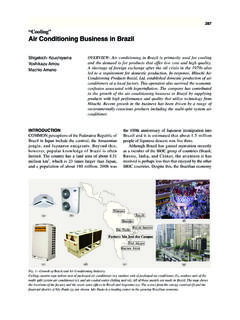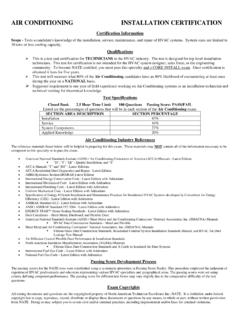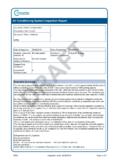Transcription of Section 609 of the Clean Air Act: Motor Vehicle Air ...
1 608 vs. 609 MVAC (609)MVAC-like (609 or 608)Non-MVAC (608) * If R-22, then 608 Aircraft passenger & cargoRefrigerated trailersShip/boat passenger & cargoPassenger carsBuses* TrucksOff-road vehiclesTrainsProtecting the Ozone LayerThe stratospheric ozone layer shields the Earth from the sun s harmful ultraviolet radiation. Emissions of certain substances including chlorofluorocarbons (CFCs), halons, and hydrochlorofluorocarbons (HCFCs) that are commonly used as refrigerants, solvents, and insulating foams destroy the ozone addition, many of these ozone-depleting substances (ODS), as well as their alternatives including hydrofluorocarbons (HFCs) are potent greenhouse gases that contribute to climate change.
2 The purpose of this fact sheet is to help understand the regulatory requirements for servicing Motor Vehicle air conditioners (MVACs).Environmental Impact of Motor Vehicle Air ConditionersOlder model MVACs used CFC-12 (also known by trade names, such as Freon ). When CFCs leak from MVACs into the atmosphere, strong radiation in the atmosphere will break the molecules apart and release chlorine atoms, each of which can destroy over 100,000 ozone can have serious impacts on climate. For example, the global warming potential (GWP) of CFC-12 is approximately 10,000 times greater than that of carbon dioxide (CO2), a greenhouse gas that contributes to climate change. Currently, most MVACs use HFC-134a (also known as R-134a), a refrigerant that does not deplete the ozone layer, but has a GWP that is approximately 1,400 times greater than CO2.
3 Alternative refrigerants such as CO2 and hydrofluoroolefin (HFO)-1234yf do not deplete the ozone layer and have much lower GWPs than CFC- 12 or HFC-134a. CO2 has a GWP of 1 and HFO-1234yf has a GWP of 4. MVACs alone represent about 15% of the global use of of the potential damage that refrigerants can do to the environment, Section 609 of the Clean Air Act (CAA) directs EPA to establish requirements to prevent the release of refrigerants during the servicing of MVACs and MVAC-like appliances and to require recycling of used refrigerants. MVAC- like appliances are mechanical vapor compression, open-drive compressor appliances used to cool the driver s or passenger s compartment of a non- road Vehicle , including agricultural and construction 609 of the Clean Air Act.
4 Motor Vehicle Air ConditioningEnvironmental Impacts of MVAC RefrigerantsOzone DepletionPotentialGlobal Warming Potential 10000 CFC-12 HFC-134aHFC-152aHFO-1234yf CO 10,9001,43012441 Section 609 Regulatory RequirementsSectiSALES RESTRICTIONS ection 609 prohibits the sale of small cans (less than 20 pounds) of CFC-12 to anyone other than an EPA-certified TRAINING AND CERTIFICATIONT echnicians repairing or servicing CFC-12, HFC-134a, and CO , HFC-152a, or HFO-1234yf MVACs must be trained and certified by an EPA-approved organization. Certification is obtained by passing an EPA-approved DISPOSAL REQUIREMENTSWhen refrigeration and air conditioning equipment enters the waste stream, the final person in the disposal chain must remove (or make certain that their customers have removed) refrigerants prior to appliance REQUIREMENTSMVAC service shops must maintain records of the names and addresses of facilities to which the refrigerant they recover is sent.
5 Service shops are also required to maintain records (on-site) showing that all service technicians are properly certified and must certify to EPA that they own approved EQUIPMENT Technicians repairing or servicing MVACs using CFC-12, HFC-134a, HFC-152a, CO , or HFO-1234yf must use refrigerant recovery equipment that is approved by CERTIFICATION REQUIREMENTSMVAC service shops must certify to EPA that they have acquired and are properly using approved refrigerant recovery equipment. Service shops must also verify that each person using the equipment has been properly trained and ProhibitionSection 608 prohibits intentionally releasing (also called venting) ODS refrigerants and most alternatives (including all HFCs, HFOs, and their blends) while maintaining, servicing, repairing, or disposing of MVACs and MVAC-like equipment.
6 CO2 refrigerants are exempted from the venting 609 Regulatory Requirements: Motor Vehicle Air ConditioningAdditional ResourcesEPA Ozone Layer Protection Website: Section 609 Website: Phaseout of Ozone-Depleting Substances Website: equipment information website: 430-F-13-004 EPA Stratospheric Ozone Information Hotline: 1-800-296-1996















